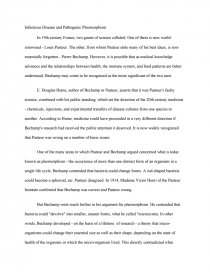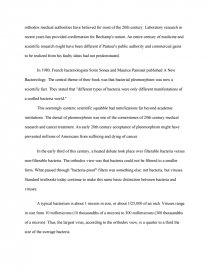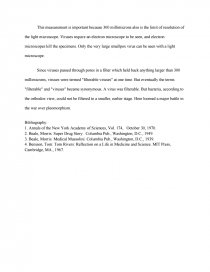Infectious Disease and Pathogenic Pleomorphism
Essay by people • November 11, 2011 • Essay • 706 Words (3 Pages) • 2,072 Views
Infectious Disease and Pathogenic Pleomorphism
In 19th century France, two giants of science collided. One of them is now world-renowned - Louis Pasteur. The other, from whom Pasteur stole many of his best ideas, is now essentially forgotten - Pierre Bechamp. However, it is possible that as medical knowledge advances and the relationships between health, the immune system, and food patterns are better understood, Bechamp may come to be recognized as the more significant of the two men.
E. Douglas Hume, author of Bechamp or Pasteur, asserts that it was Pasteur's faulty science, combined with his public standing, which set the direction of the 20th century medicine - chemicals, injections, and experimental transfers of disease cultures from one species to another. According to Hume, medicine could have proceeded in a very different direction if Bechamp's research had received the public attention it deserved. It is now widely recognized that Pasteur was wrong on a number of basic issues.
One of the many areas in which Pasteur and Bechamp argued concerned what is today known as pleomorphism - the occurrence of more than one distinct form of an organism in a single life cycle. Bechamp contended that bacteria could change forms. A rod-shaped bacteria could become a spheroid, etc. Pasteur disagreed. In 1914, Madame Victor Henri of the Pasteur Institute confirmed that Bechamp was correct and Pasteur wrong.
But Bechamp went much further in his argument for pleomorphism. He contended that bacteria could "devolve" into smaller, unseen forms, what he called "microzymia. In other words, Bechamp developed - on the basis of a lifetime of research - a theory that micro-organisms could change their essential size as well as their shape, depending on the state of health of the organism in which the micro-organism lived. This directly contradicted what orthodox medical authorities have believed for most of the 20th century. Laboratory research in recent years has provided confirmation for Bechamp's notion. An entire century of medicine and scientific research might have been different if Pasteur's public authority and commercial gains to be realized from his faulty ideas had not predominated.
In 1980, French bacteriologists Sorin Sonea and Maurice Panisset published A New Bacteriology. The central theme of their book was that bacterial pleomorphism was now a scientific fact. They stated that "different types of bacteria were only different manifestations of a unified bacteria world."
This seemingly esoteric scientific squabble had ramifications far beyond academic institutions. The denial of pleomorphism was one of the cornerstones of 20th century medical research and cancer treatment. An early 20th century acceptance of pleomorphism might have prevented millions of Americans from suffering and dying of cancer.
In
...
...


